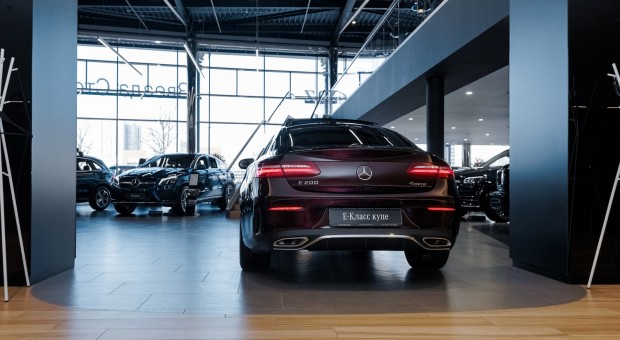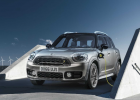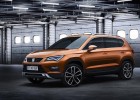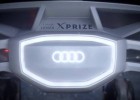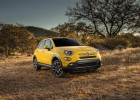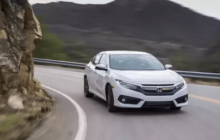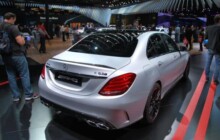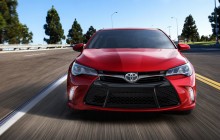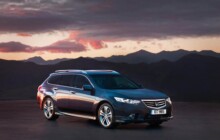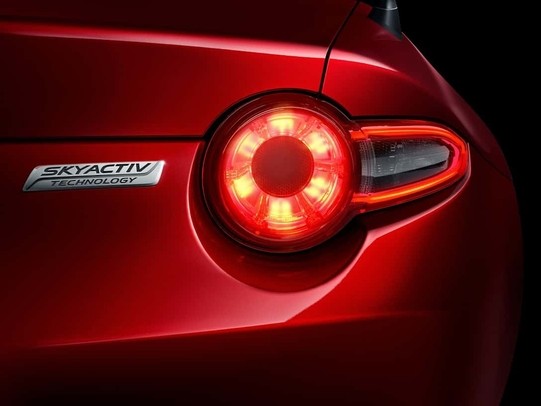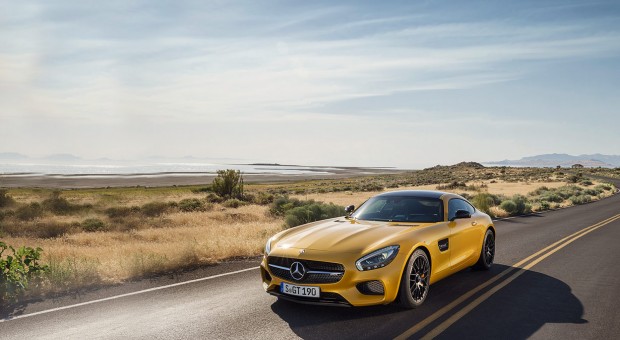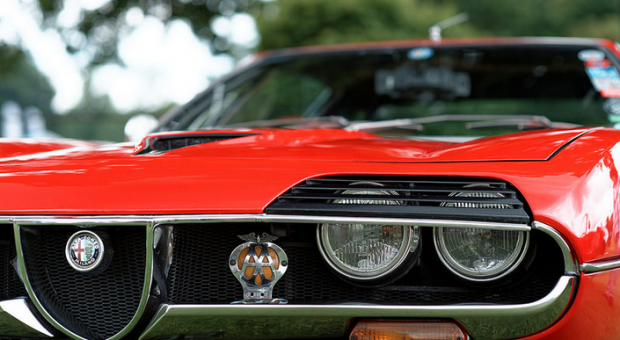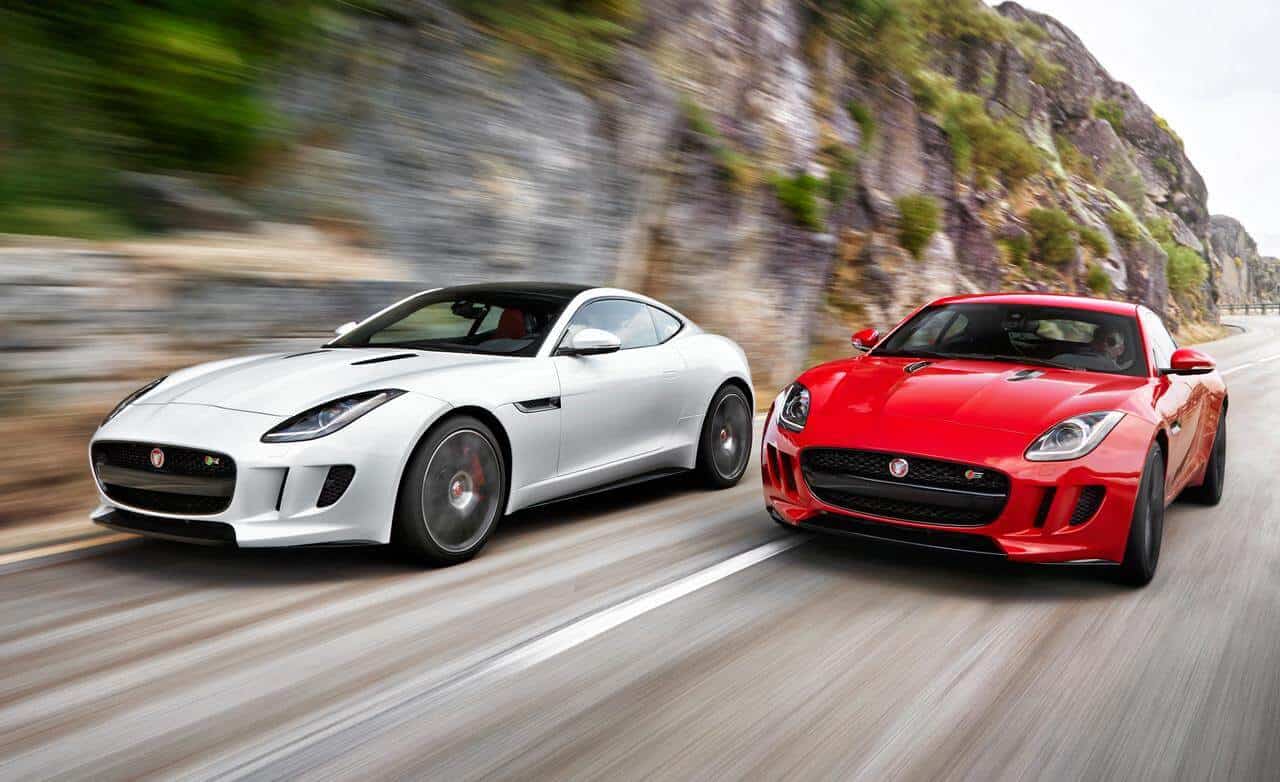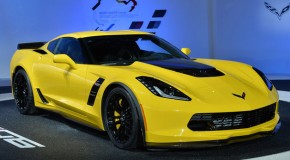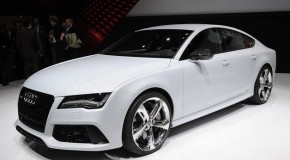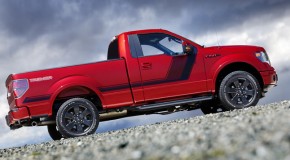The quattro models from Audi
More than 30 years after the introduction of quattro drive, today Audi is the world’s leading premium-segment manufacturer of passenger cars with permanent all-wheel drive. The current model lineup includes more than 120 quattro variants; several models are available exclusively with all-wheel drive. From 1980 through the end of 2010, Audi produced roughly 3.7 million cars with quattro drive. In addition to the volume models, the S and the RS models also play an important role here.
Production models
The first Audi with permanent all-wheel drive debuted at the Geneva Motor Show on March 3, 1980. It was simply called the Audi quattro and advertised its rugged character with a new, chiseled body. Its turbocharged five-cylinder engine developed 147 kW (200 hp) and 285 Nm (210.21 lb ft) of torque from 2,144 cc displacement. This made the quattro, which is referred to today as the Ur-quattro (original quattro), a very fast sports car, accelerating from 0 to 100 km/h (62.14 mph) in 7.1 seconds on its way to a top speed of 222 km/h (137.94 mph).
Beginning in 1982, Audi gradually added additional all-wheel drive models to the first quattro. The first TDI with quattro powertrain, the A6 2.5 TDI quattro, followed in 1995. The compact Audi models – the A3 and TT lines – have also been available with permanent all-wheel drive since 1998. Today Audi offers the quattro drive in every model series from the A3 upward.
The Audi Q5
The Audi Q5 features quattro drive as standard. The performance SUV combines the dynamics of a sports sedan with a highly variable interior. The tailgate and the engine hood are made of lightweight aluminum. The body integrates a large proportion of high-strength and ultra-high-strength steels, which reduce the weight and improve rigidity, vibrations and crash safety.
Interior space is generous, and the luggage compartment’s base capacity of 540 liters (19.07 cubic ft) can be increased to 1,560 liters (55.09 cubic ft) by folding down the rear seat backs. Audi offers a sliding rear bench seat and a folding seat back for the front passenger’s seat as options.
Audi offers the Q5 with a choice of six engines: three gasoline engines and three TDI units. The torque of the gasoline engines is further boosted by the Audi valvelift system, which switches the valve lift in two stages. The Q5 recovers energy during braking regardless of the engine installed. The range begins with the 2.0 TFSI quattro with 132 kW (180 hp) and ends with the 176 kW (240 hp) 3.0 TDI quattro. A six-speed manual transmission is standard with the four-cylinder engines; the seven-speed S tronic is available as an option with the most powerful four-cylinder gasoline and TDI engines. The dual-clutch transmission is standard with the 3.2 FSI and the 3.0 TDI.
The chassis also contributes to the sporty character of the Audi Q5. The optional Audi drive select manages the engine’s throttle response, the steering characteristic and the shift points of the S tronic. Audi offers adaptive damper control and dynamic steering as additional system modules. The Audi Q5 also holds its own in rough terrain: the electronic stabilization program (ESP) and anti-lock brake system both have an offroad mode.
The Audi A7 Sportback
Audi is once again breaking new ground in design with the Audi A7 Sportback, whose lines convey aesthetic athleticism and elegance on a grand scale. Measuring 4.97 meters (16.31 ft) in length, the five-door model is an Audi in a new top form. Its low, dynamically drawn roofline lends it the character of a coupe. Optional LED headlights up front accentuate its distinctive appearance; LED tail lights are standard.
Audi offers the A7 Sportback with a choice of four powerful and cultivated V6 engines: two gasoline and two TDI units. They produce between 150 kW (204 hp) and 220 kW (300 hp), and their efficiency sets new standards in the vehicle class.
The new 3.0 TDI with 150 kW (204 hp), which will be available somewhat later, consumes on average just 5.3 liters of fuel per 100 km (44.38 US mpg), corresponding to CO2 emissions of just 139 g/km (223.70 g/mile). All engines feature a recuperation system, innovative thermal management and a start-stop system.
The standard automatic transmissions also play a role in the high efficiency of the Audi A7 Sportback. Audi offers two different transmissions: The convenient multitronic sends engine power to the front wheels, the sporty seven-speed S tronic to all four wheels. The quattro permanent all-wheel drive system is paired with the crown-gear center differential and torque vectoring. A sport differential at the rear axle is available as an option.
Chassis
The chassis, too, combines sporty precision with luxurious comfort. The A7 Sportback rolls on large wheels measuring from 18 to 20 inches in diameter. The links are made of aluminum; the newly developed power steering features an electromechanical drive. The Audi drive select dynamics system is standard and can be supplemented by the optional adaptive air suspension. Dynamic steering will be available somewhat later.
The sinewy sportiness of the exterior carries over into the interior of the A7 Sportback, where all of the details document the care with which Audi builds cars. High-quality new materials, such as layered wood veneers, indulge the senses. The front seats are available with optional ventilation and massage functions.
The five-door coupe combines supreme long-distance comfort with a sporty character. The excellent vibration behavior is the result of painstakingly tuning all components, systematic hydraulic damping in the axle and drivetrain bearings, and the extremely stiff body. Comprised primarily of aluminum and high-tech steels, it is extremely lightweight and very safe. The long rear hatch opens to reveal a large luggage compartment.
The A7 Sportback offers a new level of technical intelligence with logical, self-explanatory ergonomics. The optimized MMI operating system comes standard; among the optional equipment is a head-up display. The groundbreaking MMI touch operating system combines a hard drive navigation system with the convenience of touchpad input.
The online services provided in collaboration with Google connect the five-door Audi coupe to the Internet via the online Bluetooth car phone. A UMTS module pulls images and information from Google Earth up on the monitor and integrates them with the navigation route. A WLAN hotspot provides contact to mobile devices on board, such as an iPad.
The top navigation system works closely together with the many optional driver assistance and safety systems in the A7 Sportback. It provides the route data to the control units for the headlights, the automatic transmission and the adaptive cruise control with stop & go function. This enables these systems to recognize complex scenarios. In many cases, the Audi pre sense safety system can reduce the severity of accidents and their consequences. The new Audi active lane assist helps the driver to keep the A7 Sportback firmly on course, and the park assist system – also new – relieves the driver of the chore of steering when parallel parking.
The Audi A8 and the A8 L
The A8 and the long-wheelbase A8 L are at the front of the luxury class. The Audi flagship boasts a lightweight aluminum body, powerful and highly efficient engines, the improved MMI operating system and a luxurious interior.
The elegant and distinctive body is an aluminum Audi Space Frame (ASF). It is roughly 40 percent lighter than a comparable steel body while also impressing with high rigidity and excellent vibration comfort. It earned Audi the Euro Car Body Award, the world’s most important award for innovative car body design. The LED headlights are another high-end solution.
The A8 is available with four direct-injection V6 and V8 engines: two gasoline units and two TDI units. The entry-level engine is the 3.0 TFSI with 213 kW (290 hp); the engine with the greatest torque is the 4.2 TDI with 258 kW (350 hp). A second variant of the 3.0 TDI will follow at a later date. It provides 150 kW (204 hp) of power, drives the front wheels and consumes only 6.0 liters per 100 km (39.20 US mpg) in the EU driving cycle.
An additional engine is available for the A8 L – the W12 is a supremely powerful and refined gasoline engine that is unusually short and lightweight. The normally aspirated, 6.3-liter engine with direct injection produces 368 kW (500 hp) and 625 Nm (460.98 lb-ft) of torque.
The standard eight-speed tiptronic features closely spaced gears while still featuring a wide spread. Its control system is purely electronic, operated with an elegant selector level and paddles on the steering wheel. The quattro permanent all-wheel drive has a distinctly sporty and rear-biased character. The optional sport differential dynamically distributes the forces between the rear wheels; this feature is standard with the 4.2-liter TDI.
The A8 and the A8 L offer both luxurious ride comfort and sporty handling. Their wheel control arms are made of aluminum. The brake discs measure up to 400 millimeters (15.75 in) in diameter, depending on the engine. The adaptive air suspension with controlled damping is standard equipment and is integrated into the Audi drive select dynamics system. It can be further supplemented by the optional dynamic steering.
The interior of the A8 enchants with new, light lines, craftsman-like fit and finish, and extraordinary attention to the smallest of details. The A8 L is 13 centimeters (5.12 in) longer than the standard version in both wheelbase and overall length (5.27 meters [17.29 ft]).
Audi offers the rear seat passengers the option of two power-adjustable and heated individual rear seats, which can be paired with the optional continuous center console.
The individual seats can also be equipped with optional ventilation and massage functions, and features such as a folding table and a cool box make the passengers’ stay even more enjoyable. The top version is the relaxation seat with power footrest. It comes complete with every available luxury option, including a rear seat entertainment system.
Similar to the A7 Sportback, the Audi A8 and the A8 L feature a new degree of technical intelligence. It manifests in the MMI operating system or the optional MMI touch, in the networking of the MMI navigation plus with other vehicle systems and in the assistance systems. The most important of these is the radar-based adaptive cruise control with stop & go function. It works closely together with the Audi pre sense safety system. Another special feature is the night vision assistant that highlights detected pedestrians.
Audi also offers many attractive multimedia modules. The top version is the Bang & Olufsen Advanced Sound System, which boasts 19 speakers. The luxury sedan is at the head of the pack with respect to Internet connectivity. It offers a WLAN hotspot and many attractive services in cooperation with Google as a service partner.
The Audi Q7
The Audi Q7 is the large, versatile performance SUV for sporty individualists. Its design stands for power and presence, with flowing surfaces forming a moving sculpture. The engine hood, the front fenders and the rear hatch are aluminum.
The Q7 engine lineup offers six efficient engines with six or eight cylinders producing between 150 kW (204 hp) with the 3.0 TDI and 250 kW (340 hp) with the 4.2 TDI. A recuperation system that recovers energy during braking is standard. Three variants of the 3.0 TDI are available. The clean diesel version complies with all U.S. emission standards and the future Euro 6 limits.
All of the engines deliver their power to the quattro permanent all-wheel drive via an eight-speed tiptronic. With its wide spread and long-ratio upper gears, the automatic transmission also makes an important contribution to good efficiency.
The Audi Q7 has a particularly sophisticated chassis. Aluminum double wishbones mounted on a separate subframe guide the wheels. Audi can also deliver the adaptive air suspension on request. Wheel sizes range from 18 to 21 inches in diameter. Large ceramic-fiber brake discs are available as options for the two most powerful models. The ESP stabilization program includes an offroad mode, and a hill descent assist is also on board.
Thanks to its luxurious 3.00 meter (9.84 ft) wheelbase, the 5.09 meter (16.70 ft) long Audi Q7 has interior room to spare. 27 different seating configurations are possible. Audi can deliver the big SUV with five, six or seven seats as desired by the customer. The seat backs in the second row can be folded, increasing the cargo capacity from a volume of 775 liters (27.37 cubic ft) to 2,035 liters (71.87 cubic ft).
Three different types of seats are available for the driver and the front-seat passenger, with heated and ventilated climate-controlled comfort seats as the top version. With its elegant lines and many upscale details, the interior conveys the typical Audi wellness feeling. Options include such luxury features as a four-zone automatic air conditioning system. Audi offers an entire system of infotainment modules, and high-performance assistance systems round out the range.
The Audi Q7 V12 TDI quattro
The Audi Q7 V12 TDI quattro is the most powerful diesel SUV in the world. Its V12 draws 368 kW (500 hp) of power from 1,750 cc displacement and delivers 1,000 Nm (737.56 lb-ft) of torque to the six-speed tiptronic between 1,750 and 3,250 rpm. Requiring just 5.5 seconds for zero to 100 km/h (62.14 mph) and with a governed top speed of 250 km/h (155.34 mph), the Audi Q7 V12 TDI quattro has the performance of a powerful sports car, yet consumes on average just 11.3 liters of fuel per 100 km (20.82 US mpg). The standard equipment of the top model includes 20-inch wheels, a ceramic brake system, the adaptive air suspension, a Bose sound system and sport seats.
The S models
Audi launched the S model family in 1990. They used abundant power, refined style and quattro permanent all-wheel drive to further cultivate the dynamic image that the brand had earned in racing.
The first S model was the Coupé S2, the successor to the first quattro. Power was provided by the 161 kW (220 hp) five-cylinder turbo of its predecessor. The S models quickly established themselves in all categories – in the compact class, the mid-size class, the full-size class, the luxury class and the TT compact sports car.
The Audi S3 and the Audi S3 Sportback
Topping the A3 model line today are the Audi S3 and the S3 Sportback with 195 kW (265 hp). The two-liter TFSI with direct injection and powerful turbocharger is a true high-performance engine, with which the S3 sets standards in its class. The three-door model sprints to 100 km/h (62.14 mph) in 5.7 seconds (with S tronic: 5.5 seconds). As with all S models, the top speed is governed at 250 km/h (155.34 mph).
The driver of the S3 changes gears via a manual six-speed transmission. In the quattro drivetrain, a hydraulic multi-plate clutch with an electronic control unit distributes the torque. The body of the S3 is 25 millimeters (0.98 in) lower than an A3 with the standard chassis. Stiffer chassis bearings and a sporty steering characteristic enhance precision. Large brakes provide the stopping power, and 18-inch wheels deliver the power to the road.
The Audi S4 and the Audi S4 Avant
The Audi S4 and the S4 Avant are powerful athletes. Their engine, the 3.0 TFSI, is supercharged and highly throttle-responsive. The V6 serves up 245 kW (333 hp) of power and 440 Nm (324.53 lb-ft) of torque together with a fuel consumption of just 9.7 liters of fuel per 100 km (24.25 US mpg) [Avant: 9.9 liters (23.76 US mpg)]. The sedan sprints from 0 to 100 km/h (62.14 mph) in 5.1 seconds; the Avant in 5.2 seconds.
Both versions come standard with a six-speed manual transmission. The sport suspension lowers the vehicle body by 20 millimeters (0.79 in), and a high-performance brake system provides powerful deceleration. The wheels are 18 inches in diameter.
Optional high-end technologies from Audi enable the S4 to extend its advantage even further. The seven-speed S tronic shifts gears within hundredths of a second; the sport differential distributes power actively and variably between the rear wheels while cornering at high speeds. The Audi drive select system enables the driver to alter the mode of operation of the engine, the S tronic and the sport differential as desired. Dynamic steering and adaptive damper control round out the package.
The Audi S5 Coupé, the Audi S5 Cabriolet and the Audi S5 Sportback
The S5 Coupé is powered by a classic, brawny, normally aspirated engine. The 4.2-liter V8 FSI generates 260 kW (354 hp) and delivers 440 Nm (324.53 lb-ft) of torque. It accelerates the two-door model to 100 km/h (62.14 mph) in 5.1 seconds. Audi offers the S5 Coupé with a sportier six-speed tiptronic transmission as an option instead of the standard six-speed manual transmission.
The S5 Cabriolet and the S5 Sportback have the same TFSI engine under the hood as the S4. The supercharged three-liter V6 engine generates 245 kW (333 hp) for superior performance. The Sportback completes the sprint to 100 km/h (62.14 mph) in 5.4 seconds, the Cabriolet in 5.6 seconds. The seven-speed S tronic is standard here.
The sport suspension has been dynamically tuned for all three S5 models. The high-performance brake system with its black calipers provides for powerful deceleration; the 18-inch wheels and wide tires deliver tenacious grip. Audi also offers the Audi drive select dynamics control system, the sport differential, the damper control system and dynamic steering as options.
The Audi TTS and the Audi TTS Roadster
Both versions of the TTS – the Coupé and the Roadster – are powered by a two-liter TFSI producing 220 kW (272 hp) and 350 Nm (258.15 lb-ft) of torque. The four-cylinder unit accelerates the TTS Coupé with S tronic from zero to 100 km/h (62.14 mph) in 5.2 seconds; the TTS Roadster completes this same exercise in 5.4 seconds.
Thanks to its largely aluminum body, the TTS is extraordinarily light, with a curb weight of only 1,395 kilograms (3,075.45 lb). When coupled with the optional six-speed S tronic, the TTS Coupé consumes an average of only 7.7 liters of fuel per 100 km (30.55 US mpg). The dual-clutch transmission changes gears with lightning speed and almost imperceptibly. The hydraulic multi-plate clutch, the heart of the quattro drivetrain, diverts torque from the front to the rear axle in just fractions of a second, if necessary.
The TTS comes standard with the Audi magnetic ride adaptive shock absorber system. In normal mode, it is well-balanced on the road. In sport mode, it leverages the potential of its suspension – which lowers the vehicle body by 10 millimeters (0.39 in)) – to achieve uncompromisingly dynamic handling. When the need arises, a high-performance brake system reliably brings the compact Audi sports car to a stop.
The RS models
Since 1994 the RS models, with their high-performance engines and quattro permanent all-wheel drive, have formed the dynamic spearhead of the Audi model range. quattro GmbH has been responsible for these vehicles since 2000.
The first model – the RS 2 based on the Audi 80 Avant – was created in collaboration with Porsche in 1994. Its 2.2-liter, five-cylinder engine used four-valve technology and turbocharging to produce a spectacular 232 kW (315 hp). Both performance and the brakes were in the same league as those of powerful sports cars. Additional RS models were added in the mid-size and full-size classes over the years, and the TT RS and RS 5 rounded out the range in 2009 and 2010.
The Audi TT RS and Audi TT RS Roadster
Five-cylinder engines are in Audi’s DNA. The TT RS features a prime example of such an engine, a turbocharged 2.5-liter engine with FSI gasoline direct injection. It generates 250 kW (340 hp) and delivers 450 Nm (331.90 lb-ft) of torque to the crankshaft. When the driver pushes the Sport button, a flap in the left exhaust tailpipe renders the five-cylinder unit’s sound even more intense and the engine’s responsiveness is boosted further.
The TT RS Coupé rockets from 0 to 100 km/h (0 to 62.14 mph) in 4.6 seconds; the Roadster in 4.7 seconds. With S tronic these same figures are 4.3 and 4.4 seconds, respectively. quattro GmbH will raise the top speed to 280 km/h (173.98 mph) upon request. The Coupé uses just 9.0 liters of fuel per 100 km (26.13 US mpg); the Roadster uses 9.1 liters per 100 km (25.85 US mpg). In combination with S tronic, these values improve to 8.5 and 8.6 liters per 100 km (27.67 and 27.35 US mpg), respectively. A recuperation system contributes to this efficiency.
The TT RS offers a choice of the tightly-spaced six-speed manual transmission and the new seven-speed S tronic. The dual-clutch transmission, which features a compact three-shaft layout, can handle high torques and is widely spaced, with its seventh gear designed as an overdrive. The S tronic includes launch control for lightning-fast starts.
The TT RS Coupé boasts a power-to-weight ratio of only 4.3 kilograms (9.48 lb) per hp; this same figure for the Roadster is 4.4 kilograms (9.70 lb) per hp. These top figures are due primarily to the extremely lightweight Audi Space Frame (ASF) bodies made of aluminum in the front and sheet steel in the rear. The Audi TT RS rolls on 18-inch wheels; four-piston calipers and drilled brake discs provide the stopping power up front. The sport suspension lowers the vehicle body by 10 millimeters (0.39 in), and the Audi magnetic ride adaptive damping system is available as an option.
The quattro competition models from Audi
Right from the start, Audi never had the slightest doubt that quattro was perfectly suited to motorsport. Audi entered the World Rally Championship in 1981 and was exceedingly successful.
Then race cars equipped with permanent all-wheel drive dominated every circuit racing competition they entered. The successes: 1988 in the North American TransAm series with the Audi 200 turbo quattro, the first oval track car in Audi history; 1989 in the most challenging touring car series in North America, the IMSA GTO, with the Audi 90 quattro IMSA GTO; 1990 in the German Touring Car Masters (DTM) with the Audi V8 quattro DTM; and 1996 in the Super Touring Car Cup (STW) and in six other international championships with the Audi A4 quattro Supertouring.
With its success in racing, quattro technology shaped the image of the Audi brand in a more enduring fashion than any advertising campaign costing millions ever could.
The Rally quattro
The idea of a rally car was every bit as old as the concept for the production car at Audi, originating in 1977. The Audi Sport Department was established the following year and became involved in rally racing with the front-wheel drive Audi 80.
The first quattro ran as a course car in the European Championship series race in Portugal. In early 1981, the quattro cars swept over the rally scene like a force of nature. Local driver Franz Wittmann won the Janner Rally in Austria, which was not a World Championship race, in a Rally quattro with a lead of more than 20 minutes over the second-place car.
The Rally quattro used the same five-cylinder turbo as the production car; the 10-cylinder engine developed a hearty 230 kW (roughly 310 hp) from 2.1 liters of displacement and 1.6 bar of boost. Lightweight body components limited its weight to around 1,200 kilograms (2,645.55 lb), roughly 100 kilograms (220.46 lb) less than the production car. Depending on the final drive ratio, the Rally quattro accelerated from 0 to 100 km/h (0 to 62.14 mph) in around 5.2 seconds on a dry surface.
At its World Championship debut in the Monte Carlo Rally, the quattro again demonstrated its superiority. Ten kilometers into the first stage, Hannu Mikkola passed a Lancia Stratos in the snow that had started one minute before him; only an accident was able to slow the Finn. Then, in the Swedish Rally, he clinched the first win. The French driver Michèle Mouton became the first woman to win a World Championship race in San Remo, and Mikkola emerged victorious again in the RAC Rally. At the end of the Audi model’s first year in action, it was placed third in the drivers’ standings.
By 1982, the quattro was already virtually unbeatable anywhere in the world; Audi easily captured the Manufacturers’ Trophy with seven victories. Mouton won in Portugal, Greece and Brazil; only a breakdown in the penultimate race in the Ivory Coast cost her the drivers’ title. However, Mikkola became champion in 1983 after winning in Finland, Sweden, Argentina and Portugal.
Audi introduced two evolutions of the competition car in quick succession during this season. The second version with the internal designation A2 ultimately developed as much as 295 kW (a good 400 hp). The weight was reduced to less than 1,100 kilograms (2,425.08 lb), in part due to an aluminum cylinder block.
The next year, too, began with a win. The newly recruited double world champion Walter Röhrl won the Monte Carlo Rally ahead of his team colleagues Stig Blomqvist (Sweden) and Hannu Mikkola. The season ended with Audi once again dominating the manufacturers’ championship with seven victories. Blomqvist posted five of those and won the drivers’ championship ahead of Mikkola.
The Sport quattro S1
Rally racing reached new heights in the 1984 season. The competitors exploited the very liberal regulations at that time in Group B to enter mid-engine cars that were pure race cars with only a visual resemblance to production models. Audi also considered a similar concept. A prototype was developed but then put back on ice.
Audi’s new weapon was the Sport quattro with a wheelbase of just 2,224 millimeters (7.30 ft) – an attempt to make the near-series front-engine concept lighter and more maneuverable by shortening it drastically by 300 millimeters (11.81 in). The “short” quattro raced from May in parallel with the Rally quattro A2, but took time to build up some momentum. Blomqvist had to wait until the penultimate race in the Ivory Coast for the first win. Audi needed to turn up the heat.
July 1, 1985 was the date of the homologation of the final stage in its evolution, the S1. The aluminum five-cylinder engine with 20 valves officially developed 350 kW (476 hp) and 480 Nm (354.03 lb ft) of torque; with a charge-air circulation system that kept the turbo engine constantly under boost, the actual figure was probably in excess of 370 kW (over 500 hp), at around 8,000 rpm. In the middle ratio the 1,090 kilogram (2,403.04 lb) S1 shot from 0 to 100 km/h (62.14 mph) in 3.1 seconds, and to 200 km/h (124.27 mph) in 11.8 seconds.
There were various differential locks to choose from for the quattro powertrain – multi-plate, Torsen and conventional. In the last race of the season, the British RAC Rally, Walter Röhrl used a dual-clutch transmission that was actuated pneumatically – a precursor of today’s S tronic. The chassis comprised a tubular space frame paneled with sheet steel and plastic; to optimize the weight distribution the radiator, fan, battery and alternator were at the rear. Large wings generated downforce on fast sections of the course.
Röhrl meticulously fine-tuned the S1 over a period of weeks in Liguria. At the San Remo Rally in October, he won 29 of the 45 stages and crossed the finish line as the winner with a lead of 6:29 minutes.
The powder keg days of Group B were numbered, however. The final blow came in spring 1986 when several spectators and participants were killed in accidents at World Championship races in Portugal and Corsica. Audi withdrew from the series, and FISA, the world governing body, approved the changeover to the near-series Group A rules. The new mid-engine car from Ingolstadt was never raced.
The S1 Pikes Peak
Following the end of Group B, the S1 was still able to celebrate one last triumph – victory in the 1987 Pikes Peak mountain race with Walter Röhrl at the wheel.
The “International Hill Climb” on the 4,301 meter (14,110 ft) mountain in the U.S. state of Colorado takes place at dizzying heights. The starting line at 2,866 meters (9,400 ft) and the finish line is at the summit 19.99 kilometers (12.42 miles) away. At that time, the serpentine course with its 156 curves consisted mainly of sand and gravel over a solid substrate of clay. The course is six meters (19.69 ft) wide on the straights and up to 15 meters (49.21 ft) wide in the corners; there are no guardrails. The course repeatedly runs along sharp edges like the edge of a table. At a point known as the “Bottomless Pit,” there is a gaping 1,800 meter (5,900 ft) drop-off.
Audi entered the Pikes Peak race for the first time in 1984. Michèle Mouton finished second in the Sport quattro; she won the race in 1985. In 1986, local driver Bobby Unser set a new record of 11:09.22 minutes in the S1; Walter Röhrl followed him the next year. His Sport quattro S1 was a concept of bare functionality pushed to the absolute limit. The five-cylinder engine pumped out 440 kW (nearly 600 hp) and 590 Nm (435.16 lb-ft) of torque. The recirculation system kept the large turbocharger spinning. A dual-clutch transmission directed the power to a quattro powertrain with three locking differentials.
Sitting behind the 16-inch tires with the cut slicks was a small and lightweight brake system developed specifically for hill climbs. The S1 weighed only around 1,000 kilograms (2,200 lb) and featured a tubular space frame paneled with steel and plastic. Massive wings at the front and rear pressed the body against the ground, and even the flanks sported vertical stabilizers.
On race day, June 11, Röhrl started second to last, before the driver with the fastest practice time, Ari Vatanen (Peugeot). As calm and collected as ever behind the wheel, the Bavarian navigated the world’s highest highway in the record time of 10:47.85 minutes. He got the Sport quattro S1 into sixth gear four times and was clocked at 196 km/h (121.79 mph) at the fastest part of the track. Röhrl beat Vatanen by nearly seven seconds.
Source: Audi Company

